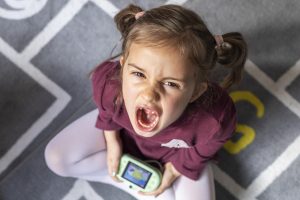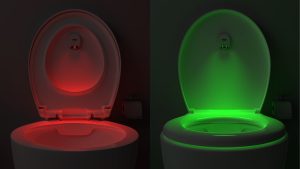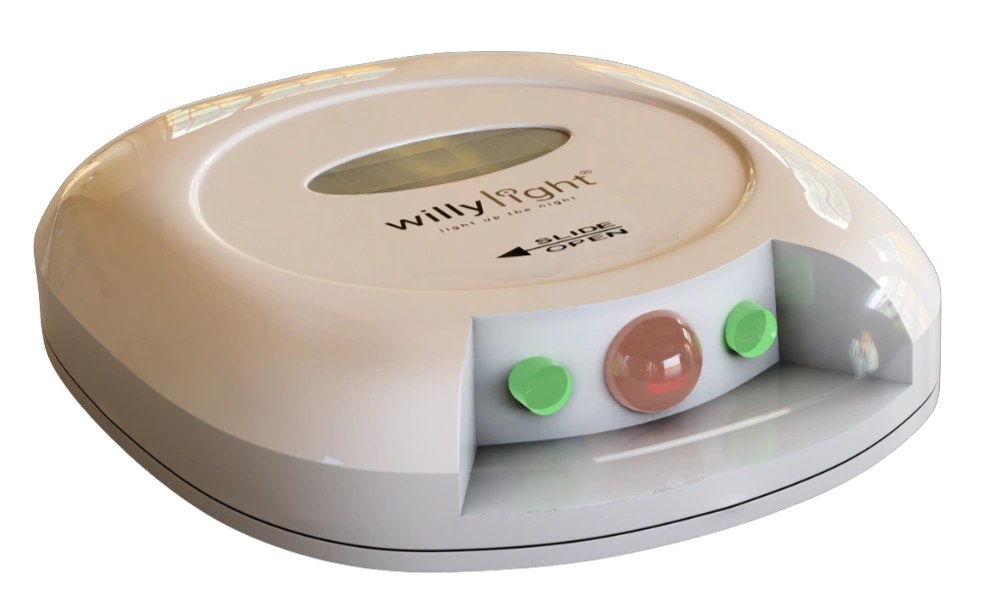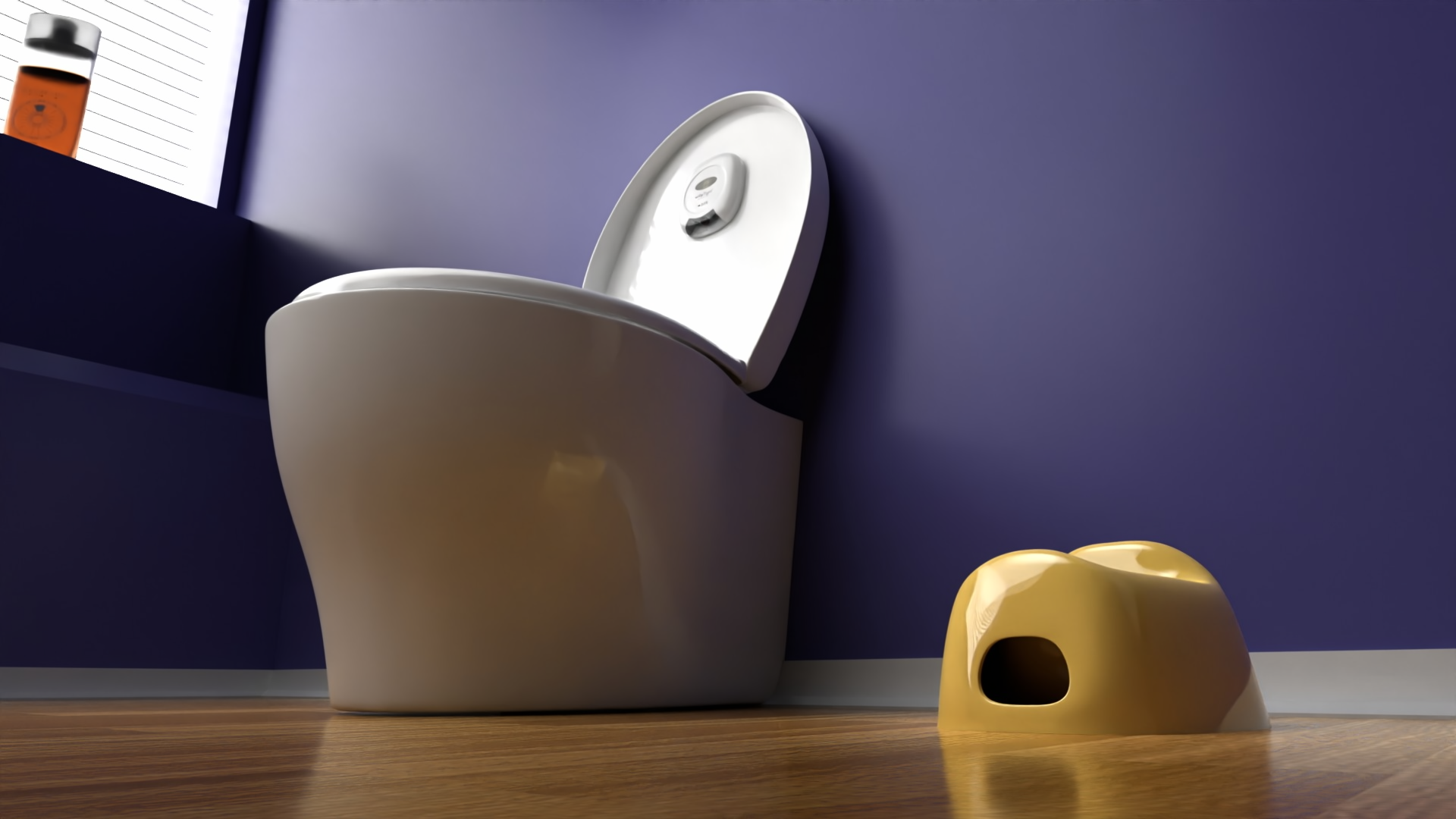Fear-based toilet training resistance affects up to 40% of children, creating months of delays, emotional stress, and family frustration. The big toilet – with its height, sounds, size, and unfamiliarity – can genuinely terrify young children, turning what should be a developmental milestone into a daily battle.
The solution isn’t pushing through fear or waiting it out, but systematically building confidence through proven tools and techniques. Visual comfort aids, especially night lights and immediate feedback systems, transform the bathroom from a scary space into a welcoming, secure environment where children feel safe and in control.
This comprehensive guide reveals the specific tools and techniques that eliminate toilet fear, helping you build your child’s confidence and create positive bathroom associations that lead to lasting success.

Three-year-old Emma would scream whenever her parents tried to bring her near the family bathroom. The toilet seemed enormous to her, the flushing sound was terrifying, and the dark bathroom at night felt like a place where monsters lived. Her parents tried everything – rewards, encouragement, even force – but Emma’s fear only intensified.
After six months of struggle, Emma’s mother discovered the real problem: they’d been trying to overcome her fear through persistence when they needed to eliminate the fear itself. By systematically addressing each scary element with specific tools – adding warm lighting, introducing visual comfort aids like the Willy Light, using sound-dampening modifications, and creating a welcoming environment – Emma’s bathroom transformed from a frightening space to her “special big girl bathroom.”
Within three weeks of implementing fear-reduction strategies, Emma was using the toilet confidently and even asking to go to the bathroom independently.
This story illustrates a crucial truth about toilet training: fear-based resistance requires completely different strategies than simple unwillingness or lack of readiness. When you build confidence instead of pushing through fear, toilet training becomes natural and stress-free for everyone.
Understanding Toilet Fear: Why Big Toilets Scare Children
Common Fear Triggers
Physical intimidation:
- Height and size differences make toilets seem enormous
- Fear of falling in or getting stuck
- Worry about balance and stability
- Vulnerability of exposed positioning
Sensory overwhelm:
- Loud, sudden flushing sounds
- Echoing bathroom acoustics
- Cold toilet seat temperatures
- Unfamiliar smells and sensations
Environmental concerns:
- Dark or dimly lit bathrooms creating anxiety
- Unfamiliar shadows and visual uncertainties
- Isolation when bathroom doors close
- Lack of control over the environment
Psychological factors:
- Loss of diaper security and familiarity
- Fear of bodily functions or “losing” something
- Anxiety about new expectations and responsibilities
- Previous negative bathroom experiences
Why Fear-Based Resistance Is Different
Children experiencing genuine toilet fear show:
- Physical symptoms (crying, shaking, clinging)
- Extreme avoidance behaviors
- Regression in other developmental areas
- Sleep disruptions related to bathroom anxiety
- Panic responses rather than simple resistance
These children aren’t being difficult – they’re genuinely frightened and need systematic confidence building rather than persistence or pressure.
The Visual Comfort Foundation
Why Visual Elements Matter Most

Children’s brains are highly visual, and what they see dramatically affects their emotional response to spaces. A bathroom that looks welcoming, well-lit, and predictable feels safe. A dark, shadowy, or unpredictable bathroom triggers fear responses.
Visual comfort creates:
- Immediate sense of safety and control
- Reduced anxiety about unknown or hidden elements
- Clear understanding of bathroom environment
- Positive emotional associations with the space
Essential Visual Comfort Aids
Warm, Welcoming Lighting
Night lights specifically designed for bathrooms:
- Gentle, warm-toned illumination that eliminates shadows
- Consistent lighting that stays on 24/7 for predictability
- Child-height positioning for their visual perspective
- Soft glow that doesn’t create harsh contrasts
Motion-activated lighting:
- Lights that turn on automatically when children enter
- Eliminates fear of dark bathroom approach
- Creates sense of bathroom “welcoming” the child
- Reduces need to fumble for switches
Visual Feedback and Comfort Systems
Immediate feedback tools like the Willy Light:
- Provide clear, friendly visual cues about proper bathroom behavior
- Create positive associations through engaging light displays
- Help children feel competent and in control
- Transform bathroom from scary unknown to interactive, manageable space
Visual cues like these work exceptionally well because they give children something positive to focus on rather than their fears.
Familiar Visual Elements
Personalized bathroom decorations:
- Child’s favorite colors or characters
- Special towels or accessories they selected
- Photos or artwork at child’s eye level
- Visual schedules showing bathroom routine steps
Sound Management Strategies
Addressing Flush Fear
Gradual desensitization:
- Let child control when flushing happens (initially after they leave)
- Demonstrate flush from safe distance with child watching
- Allow child to flush while you hold them securely
- Progress to independent flushing when ready
Sound modification tools:
- Soft-close toilet seats that reduce noise
- Flush volume reducers where available
- Sound dampening materials in bathroom
- Explaining flush sounds in non-scary terms
Alternative approaches:
- Waiting to flush until after child leaves bathroom initially
- Using toilets with quieter flush mechanisms
- Creating positive associations with flush sounds (songs, games)
Managing Echo and Acoustics
Environmental modifications:
- Soft bath mats that absorb sound
- Fabric window treatments instead of hard blinds
- Towels and soft elements that dampen echoes
- Music or white noise to mask bathroom sounds
Physical Comfort and Security
Making the Toilet the Right Size
Quality toilet seat inserts:
- Secure, stable attachment that doesn’t shift
- Appropriate sizing that feels snug and safe
- Comfortable padding or temperature-neutral materials
- Easy grip handles for added security (some models)
Sturdy step stools:
- Wide, stable platform for confident standing
- Anti-slip surface for security
- Appropriate height for easy mounting
- Doubles as security for sitting balance
Temperature Comfort
Addressing cold seat fears:
- Padded toilet seat covers that feel warmer
- Quick-warming seat covers that activate with body heat
- Explaining temperature sensations before they occur
- Gradual introduction during warmer weather if possible
Balance and Security
Supporting stable positioning:
- Step stools that support feet firmly
- Toilet seat inserts that won’t slip or move
- Potty training seats with support handles
- Parent proximity during early attempts
Environmental Transformation Strategies
Creating a Welcoming Bathroom Space
Step 1: Child’s perspective assessment
- Get down to your child’s eye level in the bathroom
- Identify what looks scary from their viewpoint
- Notice dark corners, shadows, or intimidating elements
- Observe what draws positive attention
Step 2: Lighting optimization
- Install warm-toned night lights in multiple locations
- Ensure no dark corners or shadowy areas
- Add visual interest lights like the Willy Light
- Test lighting at different times of day

Step 3: Personalization
- Let child choose bathroom decorations or accessories
- Add familiar, comforting elements from their room
- Display their “bathroom helper” chart or progress tracking
- Create sense of ownership and control
Step 4: Accessibility
- Position all necessary items within child’s reach
- Organize bathroom clearly and predictably
- Use visual markers for where things belong
- Make bathroom navigation simple and logical
Color Psychology for Comfort
Colors that reduce anxiety:
- Soft blues and greens (calming, peaceful)
- Warm yellows (cheerful, welcoming)
- Gentle purples (soothing, comfortable)
- Avoid harsh reds or intense colors that may stimulate rather than calm
Implementation strategies:
- Colored night lights in calming tones
- Towels and accessories in chosen comfort colors
- Paint or decorative elements if undertaking renovation
- Temporary decorations for rental situations
Age-Specific Fear Reduction Techniques
Ages 18-24 Months: Foundation of Familiarity
Focus: Positive bathroom associations without pressure
Effective techniques:
- Frequent bathroom visits for observation only
- Playing in bathroom (with supervision) to reduce foreignness
- Reading books in bathroom to create positive associations
- Introducing visual comfort aids early as normal bathroom features
Tools that help:
- Gentle night lights
- Favorite toys visiting bathroom
- Music or songs during bathroom time
- Zero pressure, pure familiarization
Ages 2-3 Years: Building Confidence
Focus: Gradual skill building with maximum support
Effective techniques:
- Practice sits fully clothed initially
- Parent remains in bathroom during all attempts
- Child controls timing and duration of bathroom visits
- Immediate praise for any bathroom approach or tolerance
Tools that help:
- Visual feedback systems that make bathroom engaging
- Comfort items allowed in bathroom
- Step-by-step visual schedules
- Age-appropriate readiness considerations
Ages 3-4 Years: Overcoming Established Fears
Focus: Systematic desensitization and competence building
Effective techniques:
- Breaking down fears into manageable components
- Addressing each fear element individually
- Creating success experiences to build confidence
- Empowering child with control and choices
Tools that help:
- Comprehensive visual comfort systems
- Detailed fear-addressing modifications
- Reward systems for facing specific fears
- Professional support if fears are intense
Ages 4+ Years: Intensive Confidence Building
Focus: Understanding fears cognitively while building skills
Effective techniques:
- Discussing fears openly and validating feelings
- Problem-solving specific concerns together
- Creating personal “bravery plans”
- Recognizing and celebrating courage
Tools that help:
- Child-chosen comfort modifications
- Responsibility-building around bathroom management
- Peer modeling when appropriate
- Specialized support for late starters with fear issues
Gender-Specific Fear Considerations
Boys: Additional Complexity Creates Fear
Boys often experience additional toilet fears because:
- Standing position creates vulnerability fears
- Height from step stool feels more precarious
- Toilet seat management adds complexity
- Multiple positions increase variables and uncertainty
Addressing boys’ specific fears:
- Begin with sitting position for security and simplicity
- Use visual feedback tools to make complexity manageable
- Provide extra stability through quality equipment
- Allow longer adjustment periods for each new skill
Girls: Different Fears, Different Solutions
Girls more commonly experience:
- Balance and falling fears due to size differences
- Privacy and vulnerability concerns
- Sensory sensitivities to cold, sounds, or textures
- Social anxiety about bathroom expectations
Addressing girls’ specific fears:
- Emphasize security and stability through equipment
- Ensure privacy and reduce vulnerability feelings
- Address sensory concerns systematically
- Build confidence through mastery and praise
The Role of Night Lights in Fear Reduction

Why Night Lights Are Essential
Physical safety:
- Prevents stumbling or accidents in dark bathrooms
- Allows clear visibility of bathroom features
- Eliminates navigation anxiety
Psychological comfort:
- Removes fear of darkness and unknown spaces
- Creates consistent, predictable environment
- Signals bathroom is safe space even at night
Practical function:
- Enables independent nighttime bathroom use
- Reduces need for parent assistance during sleep hours
- Supports nighttime training progression
Choosing Effective Night Lights
Key features:
- Warm, gentle glow (not harsh blue-white light)
- Continuous operation (not motion-activated for night use)
- Low enough brightness to not disrupt sleep
- Positioned to illuminate without creating scary shadows
Advanced options:
- Dimmable lights that adjust to time of day
- Color-changing options in calming tones
- Fun shapes or designs that appeal to children
- Dual-purpose lights like the Willy Light that provide both comfort and functional feedback

Immediate vs. Long-Term Strategies
Immediate Fear Reduction (Week 1-2)
Priority actions:
- Install warm bathroom lighting immediately
- Add visual comfort aids and night lights
- Remove or modify obviously scary elements
- Begin positive bathroom associations
Quick wins:
- Let child choose one special bathroom item
- Start bathroom playtime (supervised, fully clothed)
- Introduce visual feedback tools as interesting features
- Create bathroom routine that feels safe and predictable
Medium-Term Confidence Building (Week 3-6)
Progressive strategies:
- Gradual increase in bathroom time and comfort
- Introduction of actual toilet training steps
- Addressing specific fears systematically
- Building competence through supported success
Measurable progress:
- Child enters bathroom without resistance
- Tolerates bathroom door closing
- Sits on toilet with proper aids
- Shows decreased anxiety symptoms
Long-Term Success (Week 7+)
Advanced goals:
- Independent bathroom use with confidence
- Positive associations maintained consistently
- Fear triggers eliminated or managed
- Skills generalized to unfamiliar bathrooms
Sustained success indicators:
- Child asks to use bathroom independently
- Shows pride in bathroom competence
- Handles variations (public restrooms) without fear
- Maintains skills during stressful periods
When Professional Help Is Needed
Red Flags Requiring Professional Input
Consider consulting professionals if:
- Fear is severe and worsening despite modifications
- Child shows signs of anxiety disorder or phobia
- Previous trauma associated with bathroom experiences
- Fear is affecting other developmental areas significantly
- Family stress is becoming unmanageable
Types of Professional Support
Pediatricians:
- Rule out medical causes of fear or resistance
- Provide general developmental guidance
- Refer to specialists when appropriate
Child psychologists:
- Address anxiety or phobia specifically
- Provide systematic desensitization protocols
- Support parents through difficult fear periods
Occupational therapists:
- Address sensory processing issues
- Provide physical modifications for comfort
- Support children with developmental delays
Success Stories: From Fear to Confidence
The Thompson Family: Visual Comfort Transformation
Emma Thompson’s bathroom fear was so severe she would hold her bladder for dangerous lengths rather than face the toilet. Her parents transformed the bathroom with warm lighting, visual comfort aids including the Willy Light, and familiar decorations.
“The Willy Light was particularly effective because it gave her something engaging to focus on rather than her fears,” explains mother Sarah. “She went from terrified to curious, and curiosity led to confidence.”
Timeline: 3 weeks from severe fear to confident independent use
The Garcia Family: Systematic Desensitization Success
Four-year-old Miguel’s toilet fear had persisted for over a year. His parents worked with a child psychologist to create a systematic desensitization plan addressing each fear element individually.
“We started with just standing in the bathroom for 30 seconds. Then sitting on the closed toilet lid. Then the toilet seat with clothes on. Each tiny step built confidence,” notes father Antonio Garcia.
Timeline: 8 weeks from complete avoidance to full bathroom independence
Practical Implementation Guide
Week 1: Assessment and Setup
- Identify specific fear triggers
- Install all visual comfort aids
- Create welcoming bathroom environment
- Begin positive bathroom associations
Week 2: Familiarization
- Increase bathroom time without pressure
- Introduce toilet training tools as interesting objects
- Allow child to control all aspects of bathroom visits
- Build positive associations through play and comfort
Week 3-4: Gradual Exposure
- Begin practice sits with full support
- Address fears as they arise with immediate comfort
- Celebrate any bathroom approach or tolerance
- Maintain all comfort modifications
Week 5-6: Skill Building
- Progress to actual toilet training attempts
- Maintain high support and immediate comfort
- Use visual feedback tools for confidence building
- Address setbacks with patience and reassurance
Week 7+: Independence Building
- Gradually reduce support as confidence grows
- Maintain comfort modifications indefinitely
- Celebrate courage and competence consistently
- Extend skills to new bathroom environments

Conclusion: Confidence, Not Pressure
Toilet training fear requires a completely different approach than simple resistance or lack of readiness. When children are genuinely frightened of the big toilet, pushing through fear only intensifies the problem and damages the parent-child relationship.
The solution lies in systematically building confidence through proven tools and techniques that eliminate fear triggers rather than forcing children to face them. Visual comfort aids – especially warm lighting, night lights, and engaging feedback systems like the Willy Light – transform bathrooms from scary spaces into welcoming, secure environments where children feel safe and in control.
Remember: every child who conquers toilet fear does so at their own pace, supported by parents who prioritize confidence over timelines. The investment in proper fear-reduction tools and patient, systematic confidence building pays dividends in faster ultimate success, better parent-child relationships, and children who develop positive associations with bathroom independence.
Your child’s courage deserves support, not pressure. Build their confidence, eliminate the fear triggers, and watch them transform from frightened to proud of their bathroom skills.
For additional support, explore our related articles on using visual cues effectively, choosing between potty and toilet approaches, age-appropriate strategies, and supporting children who need extra help.




